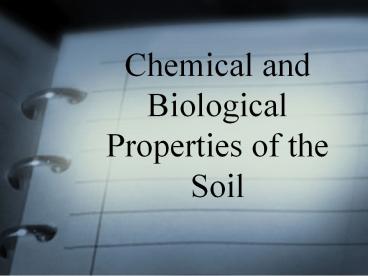Chemical and Biological Properties of the Soil - PowerPoint PPT Presentation
Title:
Chemical and Biological Properties of the Soil
Description:
Title: Chemical and Biological Properties of the Soil Author: emilee ann Last modified by: emilee ann Created Date: 8/18/2005 3:23:08 PM Document presentation format – PowerPoint PPT presentation
Number of Views:1226
Avg rating:3.0/5.0
Title: Chemical and Biological Properties of the Soil
1
Chemical and Biological Properties of the Soil
2
Lesson Objectives
- Describe the properties of acids and bases.
- Differentiate between strong and weak acids,
strong bases and weak bases. - Use the pH scale to calculate and measure the
concentration of oH. - Relate soil pH to nutrient availability.
3
Lesson Objectives continued
- Investigate the effect of soil pH on plant
growth. - Develop a plan for changing soil pH to meet crop
needs. - Determine how to take a soil sample for testing.
4
What is the pH scale?
- The pH scale measures how acidic or basic a
solution is.
5
The pH scale
- The pH scale is the concentration of hydrogen
ions in a given substance.
6
Identifying Acids and Bases
- Acids have a ph from 0-7
- Lower pH value indicates a stronger acid.
- Bases have a pH from 7-14
- Higher pH value indicates a stronger base.
7
Definitions of Acids and Bases
- An acid is a substance that breaks into
ions in an aqueous solution. - A Base (alkaline) is a substance that breaks into
ions in an aqueous solution. - Note aqueous solution is any solution where
is the solvent.
8
Did we Miss something??
- What happens when the pH of a substance is 7?
- Ans A pH level of 7 indicates a Neutral
Substance i.e Water!
9
Test Your Knowledge
- What is the range of an ACID on the pH scale?
- Ans 0-7
- What is the range of a BASE and what is another
name for a BASE? - Ans 7-14, Alkaline
10
Characteristics Of Acids
- Acids can be characterized by
- A sour taste.
- It turns blue litmus paper red
- It tastes sour. Try drinking lemon juice (citric
acid)
11
Characteristics of Bases
- A Base is characterized by
- A bitter taste. (Milk of Magnesia)
- It feels slippery. (Soapy Water)
- It turns Red Litmus Blue.
12
pH Scale
- Each pH point multiplies acidity by a factor of
10. - A pH of 5.0 is 10 times more acid than pH 6.0 and
100 times more acid than pH 7.0.
13
Why Learn about Acids Bases?
- What do you think is the pH level of (Your Town)
tap water? - The pH of a swimming pool must be checked
periodically. Why? - Is it important for Lakes Rivers to maintain a
certain pH?
14
How to calculate concentration of OH-?
- OH- 14 - pH
15
Soil pH requirements
Beans 6.0-7.0
Broccoli 6.0-7.0
Cabbage 5.6-6.6
Cantaloupe 6.0-7.0
Cauliflower 6.0-7.0
Cucumber 5.0-6.0
Eggplant 5.0-6.0
Garlic 5.0-6.0
Okra 6.0-8.0
Peanuts 5.0-6.0
16
(No Transcript)
17
Symptoms of nutrient deficiencies
- Deficiency- plant condition where an essential
nutrient is not sufficiently available. - Symptom- a visual sign or condition that results
from a deficiency
18
Primary nutrient deficiency symptoms
- Nitrogen (N)
- Stunted and spindly
- yellow, yellowish green or light green in leaf
color (chlorosis) - Older leaves affected first, starting at the tip
and moves along the middle of the leaf
19
Primary nutrient deficiency symptoms
- Phosphorus (P)
- - stunted growth
- Very dark green color
- Purple leaves or portions of leaves in advanced
stages - Older leaves affected first
20
Primary nutrient deficiency symptoms
- Potassium (K)
- Shorter plants
- Bronzing or browning of leaf color
- Lodging (bending of stem) occurs
21
Secondary nutrient deficiency symptoms
- Sulfur (S)
- Young plants have stunted appearance
- Leaves have light-green to yellow coloring
- Stems are thin and spindly
- Sulfur deficiency symptoms are similar in
appearance to Nitrogen deficiency symptoms
22
Secondary nutrient deficiency symptoms
- Magnesium (Mg)
- Leaf parts between veins show a whitish color
- Leaf tissue becomes yellow, veins remain green
- Leaves curl upward along the margins
23
Macronutrients
- Nitrogen
- Phosphorus
- Potassium
- Calcium
- Magnesium
- Sulfur
24
Micronutrients
- Boron
- Copper
- Iron
- Chloride
- Manganese
- Molybdenum
- Zinc
25
pH
- Determines the solubility and availability of
nutrients - General range for most cases 6.5 to 7
26
Biological Effects on pH
- More organic matter (decaying plant matter and
animal debris) lowers soil pH - More organic matter can support larger number of
microorganisms - Microorganisms release Nitrogen into the soil and
make N more available
27
Effect of pHon nutrient availability
28
Cation Exchange Capacity
- soils ability to exchange and retain cations
- cation- positively charged ion
- anion- negatively charged ion
- A high CEC soil will be able to resist changes in
pH
29
Macronutrients
- Most macronutrients are more available within a
pH range of 6.5 to 8. - the exception to this is P, which likes the pH to
be from 6 to 7. - Ca, K, and Mg are prone to leaching at a low pH.
- Plant uptake of N and P is restricted at pH below
6.
30
Micronutrients
- Most micronutrients (B, Cu, Fe, Mn, Ni, and Zn)
are more available within a pH range of 5 to 7 - Metals (Cu, Fe, Mn, Ni, and Zn) and bound tighter
to the soil at high pH. Low pHs can cause
toxicities. - Micronutrients decrease in availability as pH
approaches 8. - Chlorine is rarely deficient at high pH levels,
but can become toxic as pH increases.
31
Steps for Soil Sampling
32
Steps for Soil Sampling
33
Steps for Soil Sampling
34
Steps for Soil Sampling
35
Steps for Soil Sampling
36
Steps for Soil Sampling

